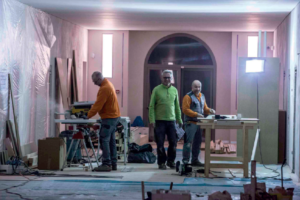CULTURE “Museums, It Is All about the Display”
“There are no nice or ugly things. You just have to display them well”. For Giovanni Tortelli and Roberto Frassoni, who were called to design and implement the inaugural exhibition at Meis, Franco Albini’s words are not only a reminder of the early years of training in the studio of Milan’s famous architect and designer. They taste more importantly like a style to be loyal to, a categorical imperative, a precise, binding approach to the profession. And also like an everyday challenge.
Mr. Tortelli explained: “The architect-museologist must make people perceive the importance of a painting, an object or an artifact even when it seems repelling, maybe because it requires a particular cognitive effort. Of course, it is much more difficult to display a shard of an oil lamp or a piece of an amphora rather than the Mona Lisa. But if no one looks at them, the blame is on the museologist, since an artwork’s setting is still its main communication tool”. So, how can one put on an effective exhibition? The GTRF studio, in Brescia (Northern Italy), has learnt a great deal from Mr. Alibini and the BBPR group, who started Italian modern museology and still represent a fundamental reference for architects in this field.
Mr. Tortelli added: “Our methodological rather than technical education, the way we deal with particular subjects and issues come from that period. For instance, we avoid special effects, because they are usually an end in themselves and distract the visitors from the actual reason they are at an exhibition or in a museum. We prefer to keep it as simple as the situation requires. No two exhibitions are the same and every time it’s a bit like starting all over again. We draw ideas from our past works and adjust our profession, sometimes turning a little bit into archeologists or art historians. We study and design the exhibition at the same time, keeping in mind our client’s demands while putting ourselves into the visitors’ shoes”.
Meis assigned “Ebrei, una storia italiana. I primi mille anni” (History of Italian Jews – The first thousand years) to the GTRF studio after an invitation-only contest. GTRF won thanks to their past work in Jerusalem, both at the archeological museum, which lies where Pilate’s Antonia Fortress used to be, and at the historical museum, dedicated to Western presence in Jerusalem after the Crusades through the Custody of the Holy Land. “We know very well about the destruction of the Temple, the Herodian Era, the rebellion, and the fall of the city. It was easy for us to get interested in the origins of the Jews and their diaspora, and to stage effective exhibitions. But any project looks easy on paper…” Indeed, turning a curator’s idea into an engaging itinerary is far from easy.
“The project sets the method, the taste and the trait, which are fundamental, and puts the materials and themes in order following its own logic. Yet, it later has to be implemented in the real space that visitors will enter. This is where the architect’s role comes into play. The architect will perfectly balance the coherence and the coexistence of the artwork and the space, modifying the latter as a last resort, since they cannot modify the objects”. Indeed, the works often entail severe restrictions on conservation, demands by the lender, and limitations on their collocation.
Mr. Tortelli added: “This time, since Meis’ exhibition is staged in a historical building, we had to communicate both the itinerary and the setting, which had recently been restored. So we tried to combine the setup, the layout of the texts, and the design of the educational sections and of the reconstruction of the maps and the architectures, as we had many small objects and fragmentary relics. They look like the splinters of a past that history and archeology have given back to us. This is to explain that even a small oil lamp was part of some contexts. For the same reason, we duplicated two Jewish catacombs for the first time, through a brand new system of colour transposition on plaster, with a mimetic effect”, he continued. “We created spaces where visitors can immerse themselves in places or situations that are not here or that are not anymore, to make them enjoy their discovery”. Here, creativity works together with technology. Mr. Tortelli warned: “[Technology] has to be controlled anyway, but at Meis we used it to stage the destruction of the Temple. The drama is represented through sounds, lights and flames”.
The goal is to catch, in a way, to engage and to take by the hand a public composed of people of different ages, education, experience, and cultural background. Much better if they go back home full of curiosity to learn more. On the other hand, some big artworks, such as the 1:1 scale mould of Tito’s frieze, gave them quite a bit of a headache. “It took us a whole day. But eventually, with everybody’s help, we managed to put it exactly where it was supposed to be”. He ended: “After all, an exhibition always has in store some surprises and obstacles. The solutions you find on site usually turn out to be the most fitting, as you can test them right away. And when they work, you realize how privileged you are, because your job brings you close to people, stories and cultures that you probably would have never met otherwise”.
The original article was written by Daniela Modonesi. It was included in Pagine Ebraiche’s December special issue “Musei” (Museums), edited by Ada Treves.
Translated by Rachele Ferin and Federica Alabiso, students at the Advanced School for Interpreters and Translators of Trieste University, interns at the newspaper office of the Union of the Italian Jewish Communities.

